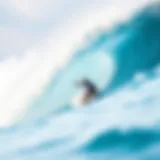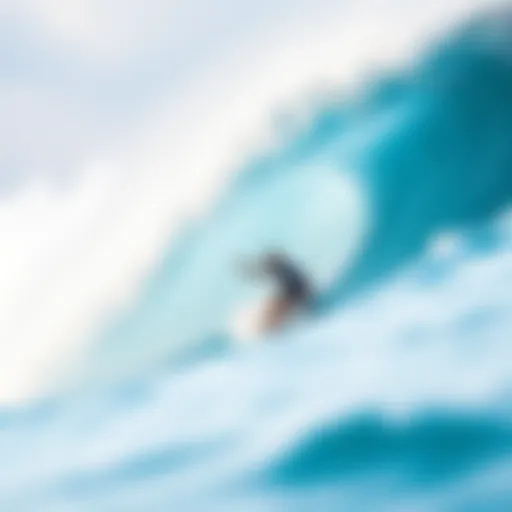Dynamics of Surfing in the Outer Banks
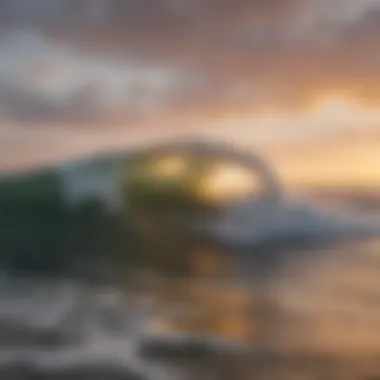

Intro
Surfing in the Outer Banks is more than just a sport; it's a rich tapestry of culture, history, and community. This stretch of barrier islands off the coast of North Carolina boasts some of the most diverse wave conditions on the East Coast, making it a prime spot for surfers of all skill levels. The unique geographical features of the area create different surf breaks that cater to both beginners eager to catch their first wave and seasoned pros searching for the perfect barrel.
In recent years, as surfing has surged in popularity, there's been a growing awareness of the environmental impact this beloved pastime can have. The surf community in the Outer Banks isn’t just about riding waves; it's also about advocating for conservation and the preservation of the beautiful coastal environment that is crucial to the sport.
This article takes a closer look at surf gear and equipment, focusing on the latest innovations that enhance performance in the water, before moving on to techniques and skills that every surfer should master. We'll also explore how local culture intertwines with surfing and conservation.
With a comprehensive view of this vibrant scene, surfers, sports enthusiasts, and environmentally conscious individuals alike will find valuable insights here that illuminate the dynamics shaping surfing in the Outer Banks.
Surf Gear and Equipment
Having the right surf gear can make or break your experience on the water. The gear is not just about aesthetics; functionality and comfort are paramount, especially when you’re riding the waves.
Latest Surfboard Technologies
Surfboard technology has advanced immensely. Modern surfboards come in various shapes and sizes, catering to different wave conditions and surfer preferences. Some notable types include:
- Shortboards: Ideal for performance surfing, offering responsiveness and speed in steep waves.
- Longboards: Perfect for those looking to cruise and catch small, rolling waves with style.
- Fish boards: A versatile option that works well for both small and larger surf.
- Foil boards: Innovative and increasingly popular, allowing for a unique flying sensation above the water.
Manufacturers are now using materials like epoxy resin and carbon fiber to create lighter, more durable boards. The right choice can greatly influence a surfer’s ability to catch waves and execute maneuvers effectively.
Essential Accessories for Surfers
Beyond surfboards, having essential accessories elevates the surf experience. Some must-haves include:
- Wetsuits: Crucial in colder waters, providing insulation and protection against the elements.
- Leashes: Attach your board to your ankle to prevent it from drifting away during wipeouts.
- Wax: For grip, ensuring that your feet stick to the surfboard when riding.
- Surf fins: Adjusting the stability and maneuverability of your board, different fins can change how it feels on the water.
Making sure you have quality gear can not only improve your performance but also enhance safety while surfing.
Techniques and Skills
To navigate the waves successfully, mastering core techniques and skills is unavoidable.
Wave Riding Strategies
Understanding how to read waves and match your movements is crucial. Here are some strategies:
- Paddling: Be sure to maintain a strong paddle, chest down to cut through water efficiently.
- Pop-up: This is the act of transitioning from lying on the board to standing up — practice makes perfect.
- Turning: Use body weight shifting to execute sharp turns as needed when catching a wave.
Safety and Surf Etiquette
Safety should always be top priority in surfing. Knowing the basics of surf etiquette can prevent accidents and encourage a positive environment. Here are some key points:
- Don’t drop in: Avoid taking a wave someone else is already riding, as it can cause collisions.
- Respect locals: Each surf spot has its own culture; take a moment to observe and follow local rules.
- Be aware of the environment: Keep an eye on currents, rocks, and other surfers to keep everyone safe.
It’s important to understand that while surfing is about ambitious exploits, respect for the ocean environment and those sharing it is crucial.
As we delve deeper into the Outer Banks’ surfing realm, we will reveal stories of local surfers, the rich culture surrounding this water sport, and the active role volunteers play in preserving these coastal lands. By tying together these threads, this exploration offers a holistic view of what makes surfing in the Outer Banks genuinely exceptional.
Prelude to Outer Banks Surfing
Surfing is not just a sport; it is a culture, an art form, and a lifestyle, especially in the scenic Outer Banks. This series of barrier islands off the coast of North Carolina plays host to a multitude of surfers eager to ride the waves. The Outer Banks is renowned for its unique and varying wave conditions, making it prime territory for both budding surfers and experienced wave riders. This section illustrates why delving into the surfing dynamics of the Outer Banks is essential—not just for surf enthusiasts but for anyone interested in the intersection of recreation and environment.
The Outer Banks offers a layered experience that is both enriched by its historical essence and framed within its geographical beauty. Surfers, sports enthusiasts, and travelers flock here not solely for the adrenaline rush, but also for the sense of community bred from the shared love of the ocean and its waves. Learning about this surfing culture provides insights into how it has shaped local traditions and lifestyles, while also reflecting broader societal values toward conservation and environmental stewardship.
Historical Context
The history of surfing in the Outer Banks is as deep as the waters that surround them. The sport itself has roots tracing back to Polynesian culture, but it found unique expression here in North Carolina. The early 20th century marked a milestone when the first boards began to appear on these shores, thanks to the influence of tourism and a growing interest in water sports. Over the decades, the Outer Banks evolved into a vibrant surf destination, with pioneers shaping the scene and ensuring its place in the surfing world.
Moreover, the local surfing community has witnessed fluctuating popularity, often influenced by cultural tides and technological advancements. The transitional phases of board designs—from wooden planks to modern fiberglass—are reflections of this rich heritage. However, it’s not just about the gear; it’s also about the stories behind these waves. Each surfer adds a unique narrative to the collective history, portraying a tapestry of experiences that bond the individuals to one another and to the sea.
"The waves hold stories untold until someone rides them."
Cultural Influence on Surfing
Cultural influences on surfing in the Outer Banks merge creativity with natural beauty. Local art, music, and food reflect this surf culture, creating an ambiance that is both welcoming and exhilarating. Kitesurfing festivals and competitions foster community engagement, bringing surfers and onlookers together to celebrate their shared passion.
With its laid-back vibe, the Outer Banks has developed an identity that encourages surfers to embrace not just the sport but the lifestyle that accompanies it. The local cuisine post-surf sessions often consists of freshly caught seafood, while beach bonfires feature musicians strumming melodies that resonate with the sound of crashing waves. Additionally, local surf shops serve more than just gear; they offer a hub for mentorship, camaraderie, and local lore, allowing newcomers to integrate smoothly into this coastal life.
In sum, understanding the interaction between surfing and local culture in the Outer Banks enriches the surfing experience. It's about riding the waves while simultaneously appreciating the rich heritage and vibrant community that has developed here.
Geographical Features and Their Impact
The geographical features of the Outer Banks significantly shape the surfing experience, playing a critical role in determining where, when, and how surfers will ride the waves. Understanding these elements provides surfers with the necessary knowledge to maximize their time in the water, ultimately enhancing their skills and enjoyment. The unique coastal topography, combined with the distinctive weather patterns, ensures an ever-evolving surf landscape where every day can offer something new and exciting.
Coastal Topography
Sandbars
Sandbars are like nature's playground for surfers, acting as a natural formation that impacts wave shape and size. These underwater mounds are formed by the ebb and flow of tides, often creating ideal conditions for intermediate and advanced surfers. The key characteristic of sandbars is their ability to create "breaks" in the waves. This can lead to perfectly formed waves that are not only fun to ride but can also build confidence in surf skills.
One unique feature of sandbars in the Outer Banks is their shifting position. They can change with the seasons and storms, which means a surfer may find a desirable wave on one day and not the next. While this variability presents a challenge, it also keeps seasoned surfers coming back for more, as they learn to adapt and read the changing conditions. However, it’s important to be cautious; the shifting nature of sandbars can sometimes hide underwater hazards.
Reefs
Reefs bring a different element to surfing dynamics in the Outer Banks. As natural structures created by corals or rocky formations, reefs can create more powerful and organized waves that challenge riders seeking to push their skills further. The primary draw of surfable reefs is their ability to generate steeper waves that break cleaner, attracting surf enthusiasts who want to test their limits.
A noteworthy aspect of reefs is their persistence. Unlike sandbars, reefs are generally stable, providing reliable surf conditions over time. However, they come with the caveat of being dangerous for beginners due to potential injuries from hitting the reef or the risk of being caught in strong currents. Safety should always be top of mind when navigating these waters.
Nearby Inlets
Nearby inlets are another fascinating feature of the Outer Banks that affect surf conditions. The inlets not only allow for the flow of water in and out, creating a dynamic environment for surfers, but they also influence tidal patterns, which can significantly alter wave features. The shape and direction of these inlets make them particularly interesting, often creating unique wave breaks during various tidal stages.
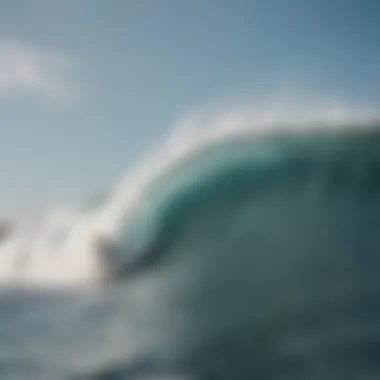

The characteristic of inlets is that they can produce varying conditions depending on the time of day and the tide, offering something for every surfer. However, while they provide incredible opportunities for waves, they can also introduce challenges due to shifting currents and potential hazards associated with the local marine life. These factors speak to a broader awareness that surfers must maintain while enjoying their time in the water.
Weather Patterns and Surf Conditions
Seasonal Variations
Seasonal variations feature prominently in shaping the surfing experience in the Outer Banks. Each season brings distinct atmospheric conditions that influence wave size and frequency. Generally, the fall and winter months are favored by surfers for their larger swells generated by storms in the Atlantic, creating more powerful waves.
The characteristic of these seasonal changes is the diversity they offer throughout the year. In general, summer provides gentler conditions suitable for beginners, while spring and autumn offer more consistent and challenging conditions for seasoned surfers. Each season presents its advantages, allowing a broad spectrum of surfing styles that cater to different skill levels.
Despite these advantages, one has to factor in the risks, especially with the sudden changes in weather. It’s crucial for surfers to keep an eye on forecasts and be aware of when conditions might become less favorable.
Storm Influence
The influence of storms on surfing can't be overlooked. Major weather events like hurricanes can generate massive waves, which, while thrilling, are also fraught with danger. The unique feature of storm-driven waves is their unpredictability; they can provide exhilarating rides for experienced surfers but pose significant risks to those less adept.
Storms often create tumultuous conditions that require a keen understanding of both the ocean and personal limits. This connection between surfing and storm systems adds a layer of complexity to the sport. Surfers in the Outer Banks often eagerly anticipate the swell generated by hurricanes, but safety is always a priority in such scenarios.
Wind Patterns
Wind patterns are another crucial factor that plays into the quality of surf during any season. Optimal winds can significantly alter wave formation, creating those well-formed lips that surfers dream about. The predominant wind direction, typically from the east, can help shape those perfect waves, giving surfers the ideal platform for performance.
The characteristic benefit of favorable wind patterns is the increased possibility of a surf-friendly day. However, winds can change rapidly and affect the wave's height and rideability. This aspect necessitates that surfers pay close attention to both the weather and the wind reports, as these factors can make or break a surf session.
In summary, the geographical features of the Outer Banks create a rich tapestry for surfers. From shifting sandbars to steady reefs and dynamic inlets, each aspect provides both challenges and rewards. Understanding these features—and how they interact with regional weather—can equip surfers, regardless of skill level, to make the most of their experience in this unique surf haven.
Diverse Surfing Techniques
The Outer Banks offers a variety of surfing experiences that cater to surfers of all skill levels. Understanding the diverse surfing techniques is crucial for honing one's skills and maximizing enjoyment. Each technique not only reflects individual style but also enhances the connection between the surfer and the waves.
Fundamentals for Beginners
Paddling Techniques
Paddling is the foundation of surfing, and mastering this skill is crucial. It involves positioning your body on the board and utilizing your arms effectively to move through the water. The key characteristic of paddling is smooth, rhythmic strokes that maintain your balance while moving towards waves. If done right, this technique ensures that you catch waves more easily.
One unique feature of paddling techniques is the ability to control your speed. By varying the intensity of your strokes, you can adjust how quickly you get to the wave. This skill is especially advantageous in turbulent conditions often found in the Outer Banks waters, where currents can challenge even seasoned surfers. On the downside, improper paddling can lead to fatigue, making it important to build endurance gradually.
Pop-Up Strategies
Once you’re catching the waves, the next step is the pop-up. This technique involves quickly transitioning from lying on the board to standing up, usually happening in a split second as you ride the wave. The key characteristic of a successful pop-up strategy is timing—how fast you react to the wave’s energy is central to this skill. This makes it a beneficial choice for surfers looking to transition from beginner to intermediate level.
One unique aspect of pop-up strategies is the importance of foot placement. Proper positioning not only affects balance but also impacts how easily you can maneuver your board once you're on your feet. Conversely, a poor pop-up can result in tumbles back into the water, which may discourage novice surfers.
Balance and Control
Balance and control are paramount when standing on the surfboard. This technique requires a keen awareness of your body positioning and the ability to shift weight smoothly. The key characteristic here is finding your center of gravity, which stabilizes your movements and helps maintain control over the board. It is beneficial, especially in the shifting and often unpredictable waters of the Outer Banks.
A unique feature of balance and control is the interplay with wave direction and momentum. Understanding how to adjust your stance relative to wave energy plays a key role in riding the wave successfully. However, not achieving balance can lead to wipeouts, which can be frustrating. Learning this technique takes time but is essential for enjoying the sport fully.
Advanced Techniques for Experts
Tricks and Maneuvers
As surfers progress to higher levels, they often explore various tricks and maneuvers to express their style and skill. These techniques can range from simple cutbacks to complex aerial moves that require precision. The key characteristic of tricks and maneuvers is creativity, allowing surfers to blend athleticism with artistry. This aspect is vital in competitions and can provide a constant source of motivation.
A distinctive feature of tricks and maneuvers is the transformation of a simple ride into an impressive display of skill. However, the challenge is the high risk involved; falling during a trick can lead to injuries. Understanding your limits is crucial in avoiding unnecessary accidents while mastering new techniques.
Wave Selection
Choosing the right wave can make or break the surfing experience. Wave selection involves analyzing wave patterns and their breaks to determine the best opportunities for riding. The key characteristic of proficient wave selection is the ability to visualize where the waves are peaking and breaking. This skill is indispensable for surfers aiming to ride the best waves in Outer Banks.
One unique feature of wave selection is its relation to environmental factors like wind and tide. Factors such as these can significantly influence wave quality and consistency. Poor wave selection can lead to missed opportunities or less enjoyable sessions.
Positioning and Timing
Positioning and timing are intertwined in surfing; knowing when and where to be on the wave impact your ride. The key characteristic of good positioning is the ability to anticipate the wave's behavior, giving surfers that edge over others. Being in the right spot at the right moment can lead to a longer and more enjoyable ride.
Unique features of positioning and timing involve various techniques, such as paddling into a wave at the perfect moment to catch it cleanly. However, a common disadvantage is the steep learning curve; mastering this skill requires practice and patience.
Remember, the journey of refining these diverse techniques is as thrilling as the ride itself, and the Outer Banks provides ample opportunity to hone each skill.
Surfboard Selection and Maintenance
Selecting the right surfboard is akin to choosing a reliable partner; it can make or break your experience on the waves. In the Outer Banks, where the surf varies from mellow to monstrous, the need for a well-suited board cannot be overstated. Each type of surfboard caters to different surf conditions, personal skill levels, and styles of riding. The maintenance of these boards plays a significant role in enhancing their performance and lifespan, ensuring that every surfer, whether a beginner or a pro, can maximize their time on the water.
Types of Surfboards
Shortboards
Shortboards are often the go-to choice for experienced surfers, primarily due to their design that allows for maneuverability and speed. Their narrow profile and pointed nose make them incredibly responsive on steep waves, which is a blessing in the dynamic surf of the Outer Banks. The agility they provide lends itself well to performing tricks and rapid turns. However, the downside comes when it’s flat; shortboards can struggle as they require more power from the waves. This can make them a less versatile option if you’re not riding consistently good conditions.
Longboards
Longboards offer a more relaxed surfing experience and are great for beginners looking to get their sea legs. With their wider shape and longer length, these boards provide excellent stability and glide, making catching waves easier. They excel on smaller swells, providing a nice ride that makes you feel like you’re on a cloud. The downside? They can be less maneuverable than shortboards, which means that advanced tricks might be off the table. Still, the art of noseriding on a longboard is a skill worth honing, especially in the mellow breaks found in the Outer Banks.
Fish Boards
Fish boards are designed for speed and agility, similar to shortboards, but with a unique twist. Their wider tails and overall shorter length give them an advantage in smaller, punchy waves, making them an ideal choice for the conditions often found in the Outer Banks. Fish boards allow for smoother turns and are generally easier to paddle than traditional shortboards, which can help in slower, less powerful surf. However, the distinctive riding style may be off-putting for some. They can be tricky for surfers accustomed to traditional shortboarding. But hey, sometimes trying something new can lead to more fun on the waves.
Care and Repair
Waxing Basics
Waxing your board is crucial; it’s like putting tires on a car. Good wax enhances grip, allowing surfers to stay upright and ride waves more confidently. The right wax can depend on water temperature, so knowing this is vital for a successful session. Applying wax regularly can prolong the life of your board and help to maintain its performance. Ignoring this simple step can lead to slips, and nobody wants that when they’re trying to catch the perfect wave.
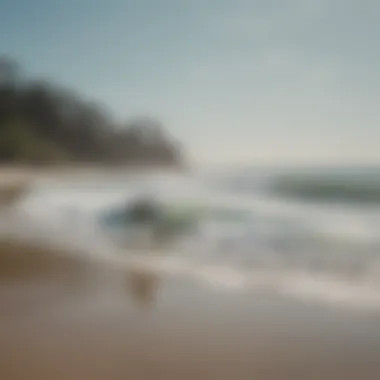

Ding Repairs
Dings happen; it’s part of the surfer’s life. Whether it’s from a rogue stick or a misplaced foot, addressing these dents is necessary for maintaining the integrity of your board. Small dings can lead to water absorption, which affects buoyancy and can make the board heavier to handle. Repair kits are handy to keep on hand; a little DIY goes a long way and helps ensure that your adventures continue without interruption.
Storage Practices
Storing your surfboard might seem mundane, but how you do it matters a lot. Keeping your board out of direct sunlight and in a cool, dry place will help prevent damage to the foam and fiberglass. Avoid leaning your board against hard surfaces where it can get dings or pressure dents. A soft bag will offer protection during transport and when storing. Proper care includes regular checks for any minor damage. These practices not only extend the life of your surfboard but also enhance performance when you paddle out.
Exploring Local Surf Culture
When one thinks about surfing in the Outer Banks, it’s not just about the waves. The local surf culture plays a crucial role in shaping the experience of both surfers and visitors alike. This community is built on shared experiences, mutual support and a deep respect for the ocean. Local surf culture embodies the rich traditions and interactions that happen on and off the water, fostering a sense of belonging and camaraderie among surfers.
Community and Competitions
Local Surf Contests
Local surf contests form the backbone of the Outer Banks' surf culture. These events bring surfers from all skill levels together, creating an atmosphere of friendly competition. They serve not just as platforms for showcasing talent but also as gathering spaces that strengthen community ties. Think of it as a big family reunion, where everyone knows each other and shares a common passion for riding the waves.
One key characteristic of these contests is their accessibility. Many are designed to include young participants, making it a fun way for newcomers to dive into the scene. A unique feature, perhaps, is the friendly rivalries that often develop, with surfers pushing each other to improve. However, it’s worth noting that not everyone enjoys the same competitive spirit; some prefer the laid-back vibe of free surfing and may find contests a bit too intense.
Surf Clubs
Surf clubs in the Outer Banks offer another layer to this vibrant culture. These groups provide surfers with the opportunity to connect, share tips, and even plan surf trips. The community aspect of clubs encourages inclusivity, welcoming people of all backgrounds. They often engage in group activities like beach cleanups or social events, promoting a sense of unity.
A notable aspect of surf clubs is their mentorship programs. Experienced surfers often take newcomers under their wings, demonstrating techniques and sharing insights about the local surf landscape. This fosters a nurturing environment, though some may argue that the informal nature can sometimes lead to differing levels of commitment among members.
Event Participation
The excitement of event participation transcends beyond competitions. Many surfers take delight in attending various surf-related events, from film premieres to workshops and surf expos. The appeal lies within the chance to learn, connect, and enjoy the laid-back atmosphere with fellow surf enthusiasts.
The key characteristic of these events is the blend of education and entertainment. Participants can gain insights from experienced surfers, get hands-on practice, and have a bit of fun while doing it. The unique aspect here is the opportunity for networking, leading to lifelong friendships and collaborations. However, it’s important to manage expectations; sometimes events may attract large crowds, diluting that intimate community feel that many cherish.
Environmental Awareness
Conservation Initiatives
As surfing grows in popularity, so does the need for conservation initiatives among the Outer Banks community. Local groups actively work on projects aimed at protecting coastal ecosystems, which are critical to maintaining the quality of surfable waves. Volunteer beach cleanups and habitat restoration efforts are some of the main components of these initiatives.
The primary benefit of conservation work is clearly evident: a healthier coastline means better waves and a more vibrant ocean. Initiatives like these serve as reminders that surfers are not just users of the ocean; they are stewards. The unique feature of these programs is their proactive stance. Instead of waiting for problems to escalate, the community takes the lead in prevention and protection. However, some participants might find it challenging to remain engaged due to the sometimes overwhelming scope of environmental issues.
Sustainable Practices
Sustainable practices have become a hot topic within the local surf culture. From eco-friendly surfboards to sustainable apparel brands, surfers in this region are increasingly making choices that contribute to environmental health. This choice reflects the community’s desire to leave a positive impact on the ocean they love.
The key characteristic here is the integration of sustainability into every aspect of surfing. Instead of just focusing on performance, many are now considering the ecological footprint of their gear. A remarkable feature of these practices is the rise of upcycled surfboards and local artisans who prioritize the environment in their production methods. While the initial cost can be higher for sustainable products, many agree it’s a worthy investment that fosters long-term benefits for both surfers and the environment.
Awareness Campaigns
Awareness campaigns play an essential role in boosting community engagement regarding environmental issues. Many local organizations work hand-in-hand with surfers to spread the word about how to protect marine life and coastlines. Such efforts include educational workshops, social media campaigns, and community forums that encourage discussion.
One notable aspect of these campaigns is their educational component, reaching beyond just surfers to engage the general public. The unique feature lies in the collaboration between surfers and environmental advocates, creating a united front for ocean conservation. However, while these campaigns do garner attention, sustaining momentum over the long haul remains a challenge, as issues can often get overshadowed by more immediate concerns.
"Surfing is not just a sport. It's a way of life that's deeply intertwined with the environment and the community. If we don't care for our ocean, we risk losing everything that makes surfing special." - Local Surfer
Fostering a deep appreciation of surfing in the Outer Banks goes beyond just catching waves; it's about understanding and engaging with the local culture's values, traditions, and efforts toward a sustainable future.
Travel and Accommodation for Surfers
Having a solid grasp on travel and accommodation is vital for surfers making their way to the Outer Banks. This coastal treasure invites both local wave riders and those coming from afar to experience its unique surfing conditions. Understanding travel logistics and where to lay your head at night can make or break a trip. Surfers, whether seasoned or fresh to the scene, need to consider elements such as timing, location, and comfort when planning their stay.
Best Times to Visit
Seasonal Highlights
One cannot overlook the significance of seasonal changes when planning a surf trip. Spring and fall are particularly special. In the spring, warmer waters beckon surfers to the coast, as the Gulf Stream nudges waves toward the shore, often accompanied by off-shore winds. Such conditions yield clean, manageable waves that cater well to all surfing levels. Conversely, autumn typically features bigger swells, drawing experienced surfers eager for a challenge.
The unique characteristic of these seasonal highlights is that they allow for varied surfing experiences. Novice surfers might gravitate towards the gentler waves of spring, while veterans seek the adrenaline that comes with those autumn swells. One downside, however, is the possibility of unpredictable weather patterns, with storms rolling in unexpectedly, potentially altering the surf landscape.
Event Schedules
Having a look at event schedules in the Outer Banks can be quite enriching for both surfers and spectators. The region hosts annual surf contests that become a hub of activity, bringing together participants and fans alike. These events often coincide with peak surf seasons, ensuring that the waves are at their prime.
The key characteristic here is the community vibe these events foster. Fellow surfers have a chance to connect, learn from one another, and swap tips while enjoying exhilarating competitions. Yet, one must keep in mind that accommodations can fill up quickly around event dates, making advance bookings essential.
Crowd Management
Understanding how to manage crowds can greatly enhance a surfer's experience. The Outer Banks can draw substantial numbers of visitors during peak seasons, leading to crowded beaches and surf spots. However, planning visits during off-peak hours—early mornings or late afternoons—might offer weary surfers a bit of peace, easing the nerves that can come with sharing waves.
The unique feature of effective crowd management is quite simple; it involves being aware of the local surf scene and adjusting one's schedule accordingly. This strategy not only maximizes wave time but also minimizes potential conflicts with other surfers. One downside, though, is that it may require some level of flexibility and patience from surfers, as finding the right moment might take a little time.
Where to Stay
Surf Camps
For those looking for an immersive experience, surf camps can be a fantastic option. These establishments cater right to the heart of surfing culture, often offering courses, gear rental, and communal living arrangements. This environment fosters camaraderie, as surfers often bond over shared experiences and daily wave challenges.
The key characteristic of surf camps is their focus on learning and community, making them highly beneficial for beginners or those looking to refine their skills. They also provide insight into local surf spots that might not be well known. However, depending on the camp's popularity, accommodations can range from cozy to crowded, leading to varying levels of comfort.
Local Rentals
Renting a home or condo can work wonders for groups or families wanting the flexibility of a kitchen and living space, especially after a long day surfing. Local rentals can usually be found at varying price points, offering options that meet different budgets and needs.
The benefit of local rentals lies in the comfort and privacy they offer, giving surfers a true home base. After countless hours spent in the water, there's something to be said about lounging on your couch or sipping coffee on a balcony overlooking the tide. One disadvantage might be the lack of on-site surf support that surf camps provide, which can be a drawback for those needing more guidance.
Traditional Hotels
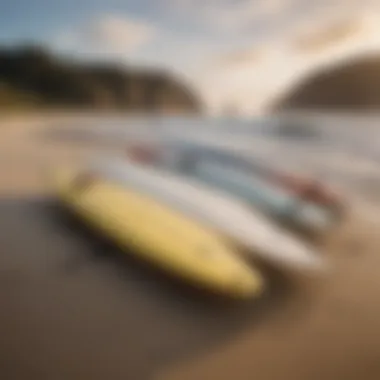

Traditional hotels round out the options available. They tend to offer familiar amenities, such as pools and dining options. Many are conveniently located near popular surf spots, reducing time spent traveling. The predictability of traditional hotels can bring peace of mind, especially for travelers unfamiliar with the area.
The key characteristic of traditional hotels is their reliability and convenience. However, as these establishments often cater to various tourists, they might lack the personal touch that comes with surf-focused accommodations. Prices can vary significantly, especially in peak season, so it's wise to check and book in advance.
Understanding these elements of travel and accommodation can set the tone for an enjoyable surfing adventure in the Outer Banks. Whether you’re there for serious riding or just to soak up the sun, planning is key.
Safety Considerations in Surfing
When it comes to surfing, safety should take center stage. The thrill of riding a wave must never overshadow the potential hazards that lurk beneath the surface or in the skies above. Understanding the key safety considerations not only enhances the enjoyment of surfing but also ensures that all riders, novice or experienced, can participate without unnecessary risks. In the Outer Banks, where the waves can change in the blink of an eye, being aware of your surroundings and the elements is crucial.
Understanding Ocean Hazards
Rip Currents
Rip currents are fast-moving, narrow channels of water that flow away from the shore. This phenomenon can become a real nightmare for unsuspecting surfers. One of the key characteristics of rip currents is how they can pull swimmers far out to sea, often faster than a person can swim back to safety.
Understanding the concept of rip currents is vital. If surfers push themselves into the water without knowledge of their local beach's current patterns, it can lead to perilous situations. The benefit of acknowledging rip currents in this article lies in educating surfers on how to identify them—look for choppy water or gaps in the waves. Knowing these signs can prevent a day on the beach from turning into a rescue mission. However, the downside is that many don’t take this warning seriously until it’s too late.
Marine Life
The marine life in the Outer Banks is another critical aspect that surfers must consider. While the ocean is teeming with vibrant life, some creatures can pose risks. Sharks might often come to mind, but encounters are quite rare. The more immediate concern involves jellyfish or even school fish, which might sting if surfers accidentally brush against them.
The unique feature about marine life in these waters is the biodiversity that exists. This diversity enriches the surfing experience. However, it can be a double-edged sword. While the chance of a thrill from spotting a dolphin is high, so is the risk of coming into contact with a more dangerous creature. Being aware and educated about local marine life can keep surfers both informed and safe.
Weather Warnings
Weather variations can drastically alter the safety of surfing conditions. Storms can churn up waves or create conditions that are too dangerous for even seasoned surfers. The key characteristic of weather warnings is that they serve as a preventive measure, cautioning surfers about impending dangers. Monitoring local weather forecasts is crucial, and heeding warnings can mean the difference between an exciting day on the waves and putting oneself in harm's way.
Local surf shops and surfing groups often provide updates on weather conditions, serving as a lifeline for enthusiasts. The challenge, however, lies in the staggered nature of weather predictions. A sunny afternoon can quickly shift to dangerous storms without much notice, so relying solely on predictions can be misleading.
First Aid Essentials
Injury Treatment
Accidents can happen when out in the water, and it’s essential to be prepared. Injury treatment encompasses everything from cuts and scrapes to more serious situations like fractures. Knowing immediate first-aid techniques can save not just a surf session but potentially a life.
One aspect that makes injury treatment a necessary consideration in surfing is the physical nature of the sport itself. Even a pro surfer can wipe out, leading to unfortunate injuries. Understanding how to clean wounds and recognize signs of infection can aid a surfer in minimizing the long-term effects. While a quick band-aid might seem sufficient, knowing when to seek professional help can be a lifesaver.
Emergency Contacts
In relation to injury treatment, having emergency contacts is paramount. Knowing who to call and, just as importantly, having access to their numbers can streamline any urgent situations. This might be as simple as saving local surf hospital numbers in your phone or knowing how to reach nearby lifeguards.
The unique feature here is that when surfing in unfamiliar waters, familiarity with local emergency services can smooth out a potentially stressful situation. But it poses a dilemma—many riders get drawn into the moment and can forget to prepare in advance for emergencies.
Safety Gear
Lastly, the topic of safety gear cannot be overlooked. While it might seem unnecessary for some experienced surfers, the benefits of using safety equipment like helmets or wet suits can’t be understated. With strengthening waves, protective gear can lessen the impact of falls or accidents.
The main characteristic of safety gear is that it acts as an added layer of security for surfers. In tricky conditions, the potential advantages far outweigh any perceived inconvenience to wear extra gear. However, despite its availability, many surfers opt to go without it, missing out on the protections it offers.
Remember, the ocean is an unpredictable force, and the smarter you are about your safety on the waves, the more enjoyable your surfing experience will be.
Each of these elements—understanding ocean hazards, first aid essentials, and the use of safety gear—plays a critical role in ensuring that surfing in the Outer Banks remains both exhilarating and safe.
Future of Surfing in the Outer Banks
The future of surfing in the Outer Banks stands at a crossroads, where historical passion meets modern innovation. This region has long been loved for its stunning waves and heavy surf community, yet times are changing. Here the challenges and opportunities arising from technological advances, evolving culture, and sustainability efforts come to the forefront. Understanding these dynamics can be vital for surfers—whether new to the break or well-versed in its swells.
Evolving Trends
Technological Advances
In recent years, technological advancements have been a game changer in the surfing world. From high-performance surfboards that enhance maneuverability to software that predicts wave conditions, these innovations have made surfing more accessible and enjoyable. For instance, smart surfboards equipped with sensors can provide real-time feedback to surfers, helping them refine their techniques on the fly.
Moreover, apps designed to track tide patterns and offer surf reports have simplified decision making for surfers heading out. One key characteristic of this tech-savvy approach is immediacy. Users can receive up-to-the-minute alerts about the best times to hit the water.
However, there are downsides, too. Not every surfer is inclined to rely on gadgets, preferring the feel of nature over mobile devices. It raises the question: does this tech-savvy direction diminish the raw experience of surfing? As cool as it may be to ride a board connected to the internet, some argue it strips away the spontaneity that makes surfing unique.
Evolving Surf Culture
Alongside technology, the surf culture in the Outer Banks is also shifting. There's a noticeable blend of traditional techniques with contemporary practices. This evolution is not merely about the sport; it's about community. Events like local competitions and surf festivals foster camaraderie and bring surfers of all ages together, encouraging mentorship and growth.
The key characteristic here is inclusivity. New surfers and seasoned veterans rub shoulders, sharing tips and stories, which can uplift the community. Yet, it’s not without its pitfalls. The growth of surf culture can sometimes alienate locals as spaces become crowded, raising the question of accessibility.
Sustainability Efforts
As surfing in the Outer Banks grows, there's also a burgeoning focus on sustainability. Local initiatives are popping up, aiming to protect marine environments and coastal ecosystems. Efforts include beach cleanups, promoting reef restoration, and advocating for eco-friendly hair products and surfboards. These practices aren't just beneficial for Mother Earth—they resonate with surfers who feel a deep connection to their playground.
Promoting sustainability also bolsters the Outer Banks' image as an eco-conscious destination. Visitors may prioritize destinations that reflect their values, making it a savvy choice for local businesses. Still, there are challenges. Balancing economic growth with environmental preservation is a constant juggling act for the region. When tourism ramps up, so do the pressures on natural resources.
Potential Challenges
Environmental Impacts
Moving forward, the environmental impacts of surfing cannot be sidelined. Shoreline erosion, habitat disruption from increased foot traffic, and waste disposal are significant concerns. The Outer Banks' ecosystems are delicate, and as surfing's popularity grows, these pressures become more pronounced.
Recognizing how community actions influence these impacts is essential. While surfer-driven beach cleanups can help, the reality is that increased visitor numbers can lead to more waste if not anticipated. Finding that balance becomes key in conserving the surf breaks beloved by all.
Tourism Management
Linked closely with environmental impacts is the challenge of tourism management. As more surfers flock to the Outer Banks, managing the delicate balance between welcoming visitors and preserving local culture is critical. Overcrowded beaches can diminish the surfing experience, turning serene spots into chaotic rumblings. Planning and strategic initiatives will be needed to ensure that key surf spots can continue to be enjoyed without sacrificing the essence of the experience.
Managing these expectations involves the local community, businesses, and government regulations creating sustainable tourism strategies. A thriving surf scene shouldn't overwhelm the existing local culture but rather enhance it, fostering economic opportunities while preserving tradition.
Economic Factors
Lastly, economic factors will continue to shape the future of surfing in the Outer Banks. Budget realities may dictate how surf schools and shops operate, especially if tourism slows or economic downturns hit. By creating alternative offerings or optimizing operations, surf-related businesses can navigate these challenges, ensuring they remain viable.
At the same time, local economies benefit from increased surfing popularity. As more surfers visit, they spend on lessons, gear, and food, creating a ripple effect. Careful consideration of these economic dynamics will ensure that surfing stays vibrant and that the community thrives alongside it.
Ultimately, the future of surfing in the Outer Banks is rich with possibilities but not without its hurdles. Balancing innovation, culture, and conservation will shape the landscape, ensuring surfing remains a cherished pastime for generations to come.










